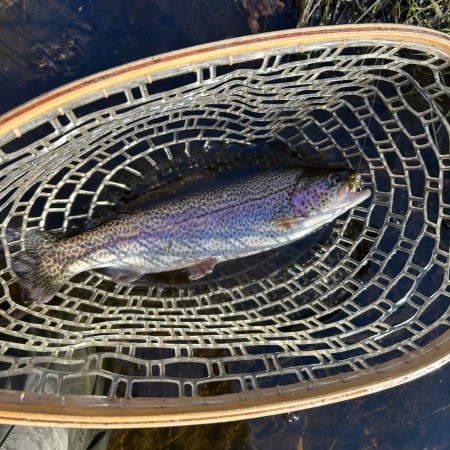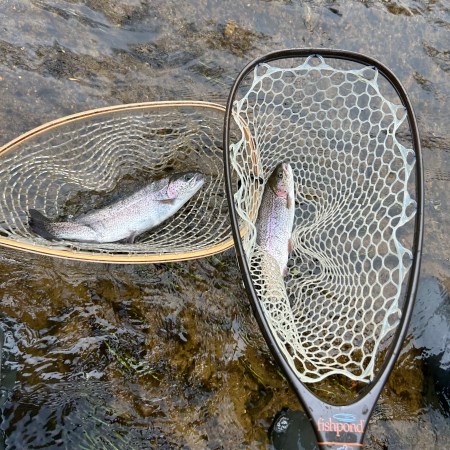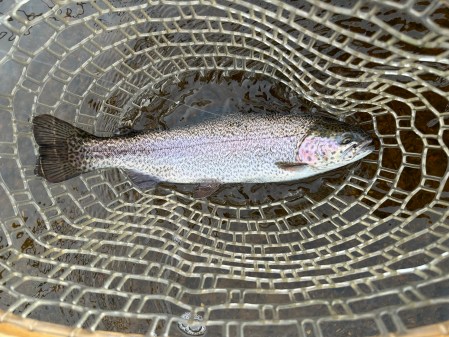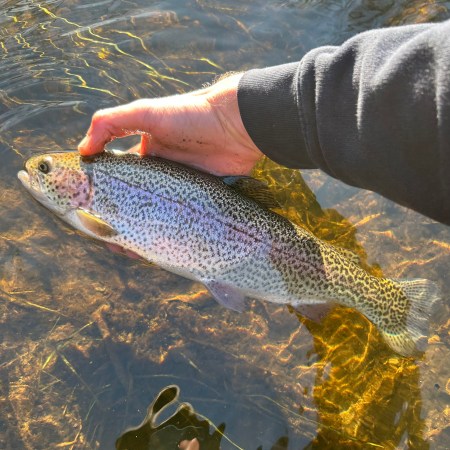Waking up at 5:20 AM daily seems to make most people cringe, but for me, the benefits outweigh the grogginess. For one, I get first dibs on the shower; I also get to eat a big breakfast before school. But perhaps the biggest upside of them all is the head-start I have on checking the trout stocking report.
I can’t be the only one whose Google immediately auto-suggests “MA trout stocking report” after simply typing in the letter “m”. Tuesday through Saturday (they don’t stock on the weekends), checking the report has become as integral a part of my morning routine as a cup of coffee. Lucky for me, that persistence means once or twice a year, I get the first shot at some freshly-stocked pellet heads.
A couple of weeks ago, I wrote about the importance of “legging up” and getting prepared for the upcoming trout season. So when I saw the Ipswich River appear on the list of stocked waters early one Wednesday morning, I already had my rods rigged, waders packed, and was on the river before the early bird even found his worm.
Somewhat surprisingly, I wasn’t the only one on the river that morning. A couple of bait-slingers already had their arsenal of powerbait rods spread about the pool, and another guy casting a spinner occupied the head of the pool. I fished for about 30 fruitless minutes in the middle water before it was time to head to school. The number of follows I had was ridiculous, though the trout seemed unwilling to commit. I may not have caught any fish that first morning, but since then, my rods haven’t left my car.

In the days following, post-track practice trips to the Ipswich, and soon the Shawsheen, became the norm. At first the weather was still nippy and the high winds made it downright bone-chilling. I’d arrive at the river sweaty after a run, only to have frozen fingers after an hour-long session. In those first few trips, I had some moderate success swinging Wooly Buggers on a sinking leader. The fishing wasn’t fast and furious, but at least I wasn’t getting skunked like many of my buddies.
I was content with those two-and-three-fish outings until fellow blog member Joel Watson showed me the ticket to success. In his first ever time fishing the river, he put all of us that regularly fish the Shawsheen to shame with a 40-fish day. I was awestruck. 40 fish is more trout than I expect to catch in a month, never mind a single day! The key, he explained, was twofold: first, I should be using tightline nymphing tactics, not swinging streamers. And second, the nymphs should be fairly natural, with a hint of attractor colors at the collar or tail. No more of those gaudy mop flies or squirmy worms.



When I began employing these new tactics, the results were immediately noticeable. Fishing with Joel, I hooked up on my second cast, he on his fourth or fifth, and just minutes later we were doubled up. A 3.2 millimeter tungsten bead paired with a size 14 nymph seemed to be the perfect combo to cut through the current and achieve a natural drift. Though I’ve always heard anglers sing the praises of junk flies when fishing for stocked trout, it seems a natural imitation may be even more enticing.
The fishing started hot-and-heavy, but soon the action dwindled off. And to be perfectly honest, that was fine; you can only catch so many cookie-cutter stocked rainbows before you start to feel stupid for even fishing for them. I was content knowing that I had put the pieces together in the stocked trout puzzle.

I went back a few more times to confirm that my success was not just a lucky occurrence. Each time I returned, I managed to hook a fish on my first or second cast, and proceeded to follow up with a few more. The one downside of tightline nymphing is the limitations in species you can target. Reports of pike in the river began rolling in, and I saw numerous hefty suckers making their upstream migration to spawn. I may have had the upper hand on spin anglers when it came to trout, but they were the only ones seeing success when it came to these unique species. Perhaps one day I’ll put together the pieces for catching these fish on the fly.
In the face of all these stockings, it’s easy to forget about wild and native species. We’re coming up on perhaps the best fishing of the year, when spring stockings combine with opportunities to chase anadromous shad, wild brookies, pre-spawn bass, migrating stripers, and a myriad of other cold and warmwater fishes. Get out there and make some spring fishing memories!


I had so many follows on the palmer river but struggled to get anything to commit for a while. However it was nice to finally have some 3 to 4 fish days, and catch fish on every outing versus the winter we’ve had. 40 fish though…that’s a whole different level!
LikeLike
Joel is a true master – he had double-digit days throughout the whole winter. I’m with you on enjoying a few fish here-and-there.
LikeLike
Pike in the Shawsheen or Ipswich?!….. I got a couple rises but no takes in the Mill River over the weekend, to an elk hair caddis, but that’s it so far for me in local rivers. I will try your tactic again before vacation week is over.
LikeLike
Pike have been coming from the Merrimack to the Shawsheen to spawn for a few years now. I’d seen pictures of them much further downstream, but had never heard of them being as far upstream as I was fishing, nevermind anyone catching them. Definitely give nymphs or buggers a try – I always have better luck with them on stocked trout than dries.
LikeLike
Pike in the Ipswich, or the Shawsheen?!…….. I went to the Mill River earlier this week and got a couple rises on an elk hair caddis, but no takes. That’s all the action I’ve gotten so far on local rivers. I will give your tactic a try before vacation week is over, but under an indicator instead. I don’t know how to tight line yet.
LikeLike
Sorry for the repeat messages I thought the first one failed to post!
LikeLike
Great read and a day dreams are made of. They just stocked our local stream last week and took the littles out and my son caught 11 in about 2 hours. It was a great day!
LikeLike
That’s awesome! Great way to get ’em started.
LikeLiked by 1 person